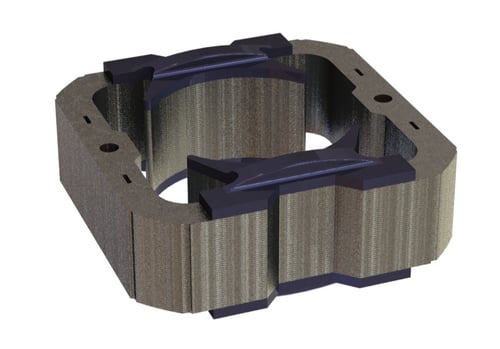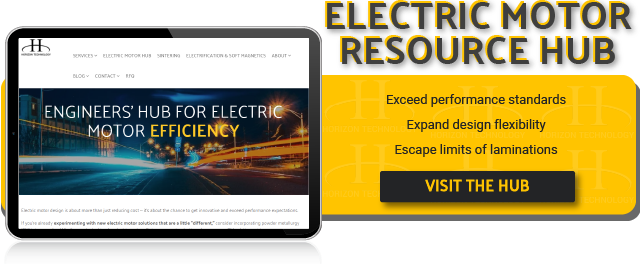Modern powder metal (PM) components first appeared in self-lubricating bearings and Lionel Train wheels. But the powder metallurgy process has evolved, just as DC and AC motor stators have evolved.
Using advanced materials like soft magnetic composites for AC motors and PM techniques like ultra-high-temperature sintering for DC motors can improve overall performance.
Keep reading to see where PM fits like a glove for AC and DC stator design -- and where they’re like oil and water.
AC Motor Stators
The AC motor has been around far longer than you might think. Nikola Tesla developed the induction motor in 1883, and the design hasn’t changed much since then, other than improvement in materials.
When powder metallurgy makes sense for AC motors, it’s typically because we can use soft magnetic composite (SMC) material. These advanced materials combine the inherent shape-making advantages of powder metallurgy with high magnetic properties.
A newer type of AC motor, the permanent magnet motor, is seeing increased use in high-demand applications. Stators using laminations have been the standard for decades. Advances in powder metallurgy have raised the bar for AC stator design and made permanent magnet motors ideal for certain applications:
- Unique motor shapes
- High-frequency operating conditions
- When you want to minimize heat in the motor core
- Compact designs
- Combinations with laminations
AC motors are most common in home applications and other equipment with high duty cycles, including:
- Wind turbines
- Refrigerators
- Freezers
- Portable hydraulics
- Exhaust fans
- HVAC
While many traditional AC applications still use three-phase induction motors, some have moved to permanent magnets – like the drive motors in electric cars. This is a potential sweet spot for adding powder metallurgy to your design.
Where Powder Metallurgy Is Less Ideal for AC Motor Design
Today, a lot of shop talk centers around permanent magnet vs. three-phase induction motors.
The latter is seeing use in a shrinking number of today’s applications. Three-phase motors aren’t particularly efficient, but are reliable and cheap to manufacture. Induction motors are inherently very efficient, but SMCs can make standard induction motors even better. Despite these improvements in standard induction motor designs, BLDCs can take overall performance to a new level.

AC applications use a variety of induction motor designs, including the squirrel cage induction motor. This type of three-phase induction motor functions on the principle of electromagnetism. Fundamentally, the squirrel cage motor is like a hamster running on a wheel. The outer cage is iron, and can move the air inside HVAC systems, for example. The cage is so complex and small that even powder metallurgy and SMCs can’t accommodate the design requirements.
DC Motor Stators
Electric motor stator design all comes down to the capabilities of the manufacturer and priorities of the end user. Let's look at some of the ways PM is used.
- Cordless power tools
- Gears in auto motors
- Self-lubricating bearings in auto motors
- Winches
- Electric bikes and electric scooters
Notably, a lot of the applications above use brushless DC motors.
In the case of personal e-transportation, powder metal’s viability comes down to whether the market can deal with a 50% increase in pricing. In new applications -- like those emerging for DC motors and those geared toward performance -- powder metallurgy absolutely makes sense because the performance improvement is worth the investment.
The need for high-performance, lightweight motors -- particularly in the electric scooter/bike market -- has driven a switch to BLDCs, which are an ideal candidate for the use of SMC materials.
Where Is Powder Metallurgy not Viable for DC Motor Stators
DC motors are used in large quantities in the automotive industry. Of the 100 or more electric motors in a modern vehicle, the vast majority are still brushed DC motors. Motors used for:
- Windshield wipers
- Fuel pumps
- Electric windows
- Power door locks
- Power mirrors
- Power seats
When it comes to motors in vehicles, manufacturers aren’t thinking about efficiency -- they’re thinking about cost. This is what turns product makers toward extrusion and welding. Even though a stator made from powder metallurgy might make these small electric motors more efficient, it’s not worth the added design time or manufacturing cost.
A modern vehicle would be so much more expensive if all 100 motors were PM-made. Extruding and welding are much more time-efficient processes for the mass production of DC motors for vehicles.
Unless a part needs a specific, complex shape, PM is not really a consideration for DC motor stator design.
Powder Metallurgy for Increased Motor Stator Efficiency
The permanent magnet motor is gradually emerging as a viable replacement for the induction motor. Right alongside this development, powder metallurgy is poised to replace lamination and other competing processes in a variety of motor applications.
If you have more questions about what PM can do for electric motor design (and whether your motor component is a fit for PM), see our new Engineers’ Hub for Electric Motor Design!



